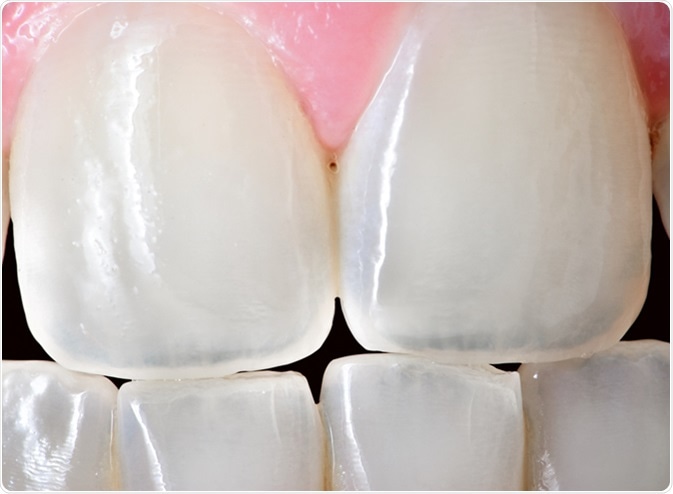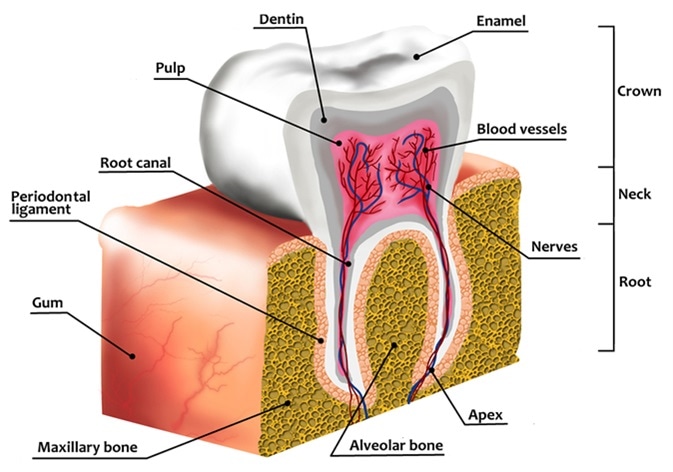What Are Teeth Made Of?

Teeth contribute to the important functions of food mastication, swallowing, digestion, speech, and aesthetics in humans. Each tooth component serves a specific purpose.

The development of human teeth begins in the womb. Children generally have their primary tooth (deciduous tooth) eruption around 6 months of age. By the age of 12, most primary teeth have been lost and secondary teeth continue to replace those teeth until adulthood.
Parts of the Human Tooth

The human tooth is divided into three different parts:
- Crown – This is the visible portion of the tooth. It covers nearly two-thirds of the total tooth structure. The crown lies above the gums (gingiva).
- Neck– The small and narrow portion lying between the crown and root of the tooth.
- Root – It consists of one-third of the tooth and is deeply seated inside the bone supporting the tooth. This part of the tooth lies below the gums and is usually not visible in healthy teeth.
Human Tooth – Sections and Composition
Human teeth are composed of multiple layers of both hard and soft tissue. Enamel, dentin, and cementum are harder sections, whereas pulp is the softer portion of tooth.
Enamel
Enamel surrounds the crown and acts as a protective covering. It varies in thickness in different parts of the tooth. It is thickest at the cuspal region of the molars and premolars. The thinnest enamel is at the neck of the tooth.
The enamel color ranges from yellow to grayish white, and generally reflects the degree of mineralization and staining on tooth surfaces.
Composition of Enamel
Enamel is formed by the ameloblast cells and it is the hardest substance of the human body due to high percentage of mineral salts in crystalline state.
Enamel consists of 95% to 98% inorganic and 1% organic substances, with water constituting 1% to 4% of the enamel.
Inorganic substances mainly consist of calcium and phosphate ions. These combine to form a high strength hydroxyapatite crystal that allows the enamel to bear high masticatory forces.
The organic substance in teeth mainly consists of enamelin proteins.
The organic and inorganic components and water are structured systematically in enamel. A well-organized structure results in the formation of long, thin enamel rods. These enamel rods are 4 to 8 µm in diameter and number approximately 5 to 12 million per tooth. They are surrounded by the enamelins, and the space between each rod is known as interrod enamel or cement.
Dentin
Dentin is covered by enamel at the crown and cementum at the root. It adds to the bulk and general form of the tooth structure. Dentin is a living tissue consisting of small tubules known as dentinal tubules. These tubules are present at the cementoenamel junction (connection between enamel and the cementum) and the pulp.
Dentin is formed by cells known as odontoblasts. Despite being calcified, dentin is slightly compressible and elastic in nature. As dentin is a living tissue, it can detect hot and cold sensations from food and drink.
Dentin is slightly yellow in color, and consists of 70% inorganic and 30% organic matter. The inorganic component of dentin is similar to enamel and contains calcium and phosphate ions. However, the hydroxyapatite crystals found in the dentin are smaller in size compared to those in enamel. This variation in size makes dentin relatively softer than enamel.
Cementum
Cementum is a bone-like structure that surrounds the root of the tooth. It acts as a medium for attaching the tooth to the bone surrounding the tooth. Cementum connects the enamel at the cementoenamel junction.
The cementum is comprised of 55% organic and 45% inorganic compounds. The organic portion of cementum consists primarily of Type I collagen and protein polysaccharides. The inorganic portion primarily consists of calcium and phosphate ions.
Pulp
Pulp is the innermost part of the tooth structure. Pulp has a rich supply of blood vessels and nerves, which help maintain tooth vitality. Pulp that is present in the crown is termed as coronal pulp, whereas pulp inside the roots is termed radicular pulp.
Pulp is also composed of neurons, fibroblasts, macrophages, and vascular tissue. It is a soft and living portion of the tooth that contains dentin-forming cells known as odontoblasts.
Sources
- www.dentalcare.com/…/dentin-structure-and-composition
- www.betterhealth.vic.gov.au/health/conditionsandtreatments/teeth
- https://bodytomy.com/human-tooth-anatomy-with-labeled-diagrams
- http://www.mydr.com.au/first-aid-self-care/tooth-anatomy
- https://www.mouthhealthy.org/en/az-topics/t/tooth
Further Reading
- All Teeth Content
- Dental Health in Children
- Foods Good for Teeth
- Tooth Polishing Procedure
- When Should Children Get Their Adult Teeth?
Last Updated: Nov 11, 2018

Written by
Akshima Sahi
Akshima is a registered dentist and seasoned medical writer from Dharamshala, India. Akshima is actively involved in educating people about the importance of good dental health. She examines patients and lends free counseling sessions. Taking her passion for medical writing ahead, her aim is to educate the masses about the value of good oral health.
Source: Read Full Article